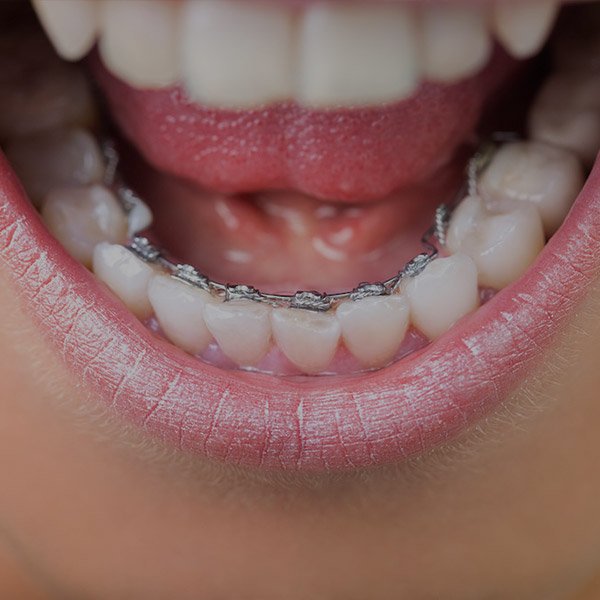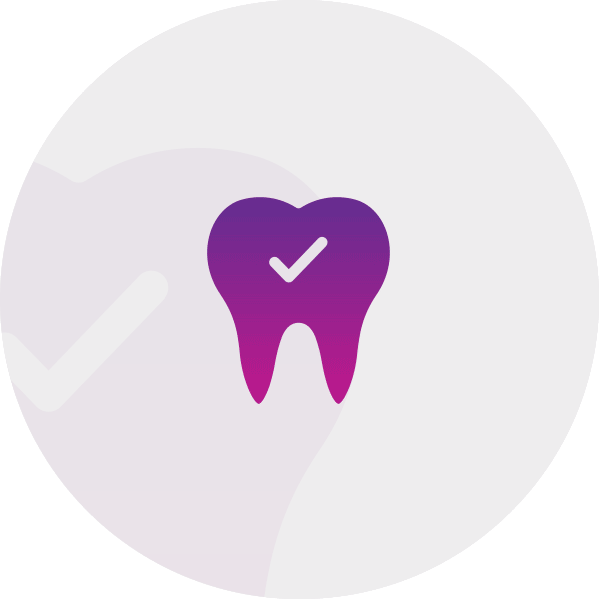Correct bite disorders, straighten teeth
and improve confidence.
Orthodontic treatment is more effective the younger you are, making teen years a great time to consider various treatment options. If your child is self-conscious about their smile or is having other issues associated with misalignment of their teeth, our orthodontists are specialists in achieving fantastic results.
Teen Orthodontics
Teen braces are the traditional and most common form of teen orthodontics. With a long history of success combined with constantly advancing technology, teenager braces are a well-known and trusted treatment for correcting smile problems.
Help your teen feel comfortable and confident in their smile with Invisalign teen; a clear and almost invisible alternative to braces. Using clear aligners to shift teeth into the desired position, treatment is quicker and less visible than ever.
While less common than braces or Invisalign, lingual braces are another really popular orthodontic treatment that work via wires on the inside of your teens’ teeth. Due to their position, lingual braces are great for anyone hesitant about visible brackets.
Dental Issues Treated
The treatment process
Consultation
Impressions
Fitting
Adjustments
Debanding
(braces only)
Retention
Frequently Asked Questions
How to tell if your teen needs braces or Invisalign
One of the most common concerns parents have when visiting their dentist is whether their child will require braces.
The first and most important thing to remember is that every child is different, which is why it’s so important to ensure your children visit the dentist regularly to check on their development and make sure any problems in the mouth are picked up early.
They have lost baby teeth early
If you notice your child losing their baby teeth too early or losing baby teeth as a result of tooth decay, they may need treatment to prevent the remaining teeth from moving or tipping into the empty spaces while the adult teeth are still growing. Treatment can help to hold these spaces open so that development can continue normally.
They have a misaligned jaw
Having a jaw that doesn’t match up correctly can cause overbites, underbites and crossbites. When your child’s jaws don’t line up properly, early intervention may be recommended to ensure the best result is achieved.
They have crowded (or crooked) teeth
When there isn’t enough space in the mouth, your child’s teeth can overlap; this is known as crowding. While your child may not require braces immediately, it does mean that their oral development needs to be more closely monitored by the dentist.
Crowding can even prevent your child from brushing and flossing properly, leading to an excess of plaque in your child’s mouth and a higher risk of tooth decay. Braces can fix this problem by straightening out the teeth and putting them in the proper position.
They have spaces (or gaps)
It’s perfectly normal for young children to have wide gaps between their baby (primary) teeth, simply because these teeth are generally smaller than permanent ones. However, if large spaces remain after the adult teeth have come through, braces might be recommended to close the gaps – especially if there are problems with speech, food trapping or appearances.
Most parents can attest that thumb or dummy sucking can be soothing for their baby or toddler. However, if this habit continues it can change the development of the jaw.
They’re mouth breathing
Children who breathe through their mouth during the day or night will have their mouth open for the majority of time to let air in. This can affect the appearance of their face and the growth of their teeth. Because their tongue is not able to sit on the roof of their mouth, your child can develop a longer face with narrow jaws. This creates a smaller amount of space for adult teeth to grow, which may result in the need for an assessment by an ear, nose and throat (ENT) specialist to check for issues with tonsils, adenoids and the airway. The ENT specialist may also recommend braces to correct jaw problems.
They have difficulty chewing
Misaligned teeth can negatively impact your child’s ability to eat comfortably. If they’re having difficulty eating or are often biting their tongue or insides of their cheeks, it could be because their bite is off or their teeth are crooked.
They have mouth or jaw pain
We can’t always see orthodontic problems — sometimes, your child may only feel the problem. If your child is experiencing mouth or jaw pain regularly, there may be an underlying orthodontic reason, so it’s important to see your orthodontist to determine what’s causing their discomfort.
They have problems with speech
Many things can cause speech problems, but sometimes it’s just a matter of misaligned teeth. If your child is having difficulty saying certain words or generally struggling with speech, it could be time to see your dentist or orthodontist, along with a speech pathologist.
How much are braces/Invisalign for teenagers?
Everyone has a different treatment path, but a safe average is to budget between $8000-$10,000. To assist with this cost, we do offer interest free payment plans for all patients.
What is the most effective orthodontic treatment for teens?
There are several options available when considering which orthodontic treatment will be best for your child. Here are a few of the options we offer at Medland Orthodontics.
Invisalign: Invisalign uses a 3-D image of your mouth to allow your Orthodontist to custom design clear aligners that guide your teeth to their desired position. While removable, Invisalign must be worn at least 22 hours each day to be effective.
Best orthodontic treatment for: Teenagers who are dependable and who understand the importance of consistent use.
Not great for: Teenagers who may forget to wear the aligners for at least 22 hours.
Suresmile Braces: Suresmile combines braces with the latest 3D technology in orthodontics. The result is a highly customized look and functionality that not only is more precise, but also more efficient. An added benefit of Suresmile is that it produces better results while reducing treatment times by about 30%. That’s something that makes all teenagers (and their parents) happy.
Not great for: Teenagers who want to avoid the “look” of braces or those who already struggle to keep their teeth clean.
When should my child see an orthodontist?
According to the Australian Society of Orthodontists, around 7 years old.
Although 7 years old seems pretty early and your child would still have baby teeth, at this age jaw growth, missing teeth, and bite relationships can be checked and treatment can be planned. The best time to treat teeth and jaw growth patterns is while kids are still growing!
There may be a crossbite, permanent teeth starting to get too crowded, or teeth that haven’t come through yet might be going off track and become impacted. If those issues are detected, monitored or treated earlier, around 8 or 9, then more serious problems can be avoided later.
For example, an underbite can be treated around 7 or 8, while the child’s jaws are still growing, which could mean avoiding jaw surgery later on.
Waiting until 13 or 14, or after the main growth spurt, the window of opportunity may have already closed for that sort of treatment.








